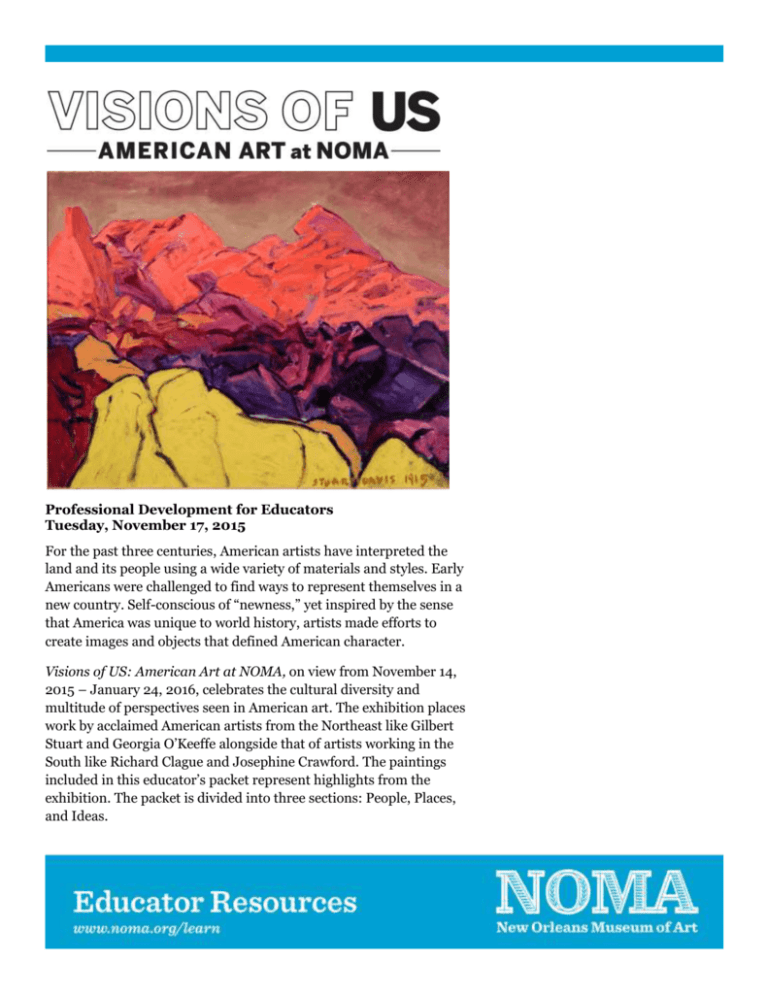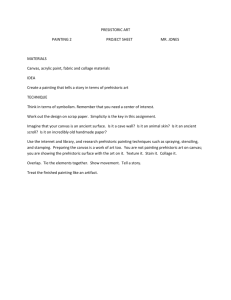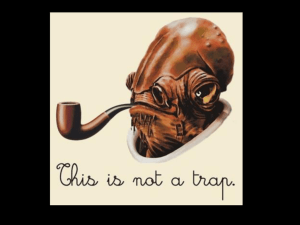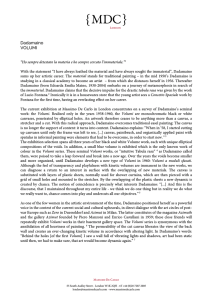Visions of US Educator Resources
advertisement

Professional Development for Educators Tuesday, November 17, 2015 For the past three centuries, American artists have interpreted the land and its people using a wide variety of materials and styles. Early Americans were challenged to find ways to represent themselves in a new country. Self-conscious of “newness,” yet inspired by the sense that America was unique to world history, artists made efforts to create images and objects that defined American character. Visions of US: American Art at NOMA, on view from November 14, 2015 – January 24, 2016, celebrates the cultural diversity and multitude of perspectives seen in American art. The exhibition places work by acclaimed American artists from the Northeast like Gilbert Stuart and Georgia O’Keeffe alongside that of artists working in the South like Richard Clague and Josephine Crawford. The paintings included in this educator’s packet represent highlights from the exhibition. The packet is divided into three sections: People, Places, and Ideas. List of Works Jonathan Singleton Copley (American, 1738-1815), Portrait of Colonel George Watson, 1768, Oil on canvas, Museum purchase and gift by exchange of Isaac Cine, Herman E. Cooper, F. Julius Dreyfous, Durand-Ruel & Sons, and Lora Tortue, 77.37 Gilbert Stuart (American, 1755 – 1828), George Washington, c. 1800, Oil on canvas, Gift of Frances Weis Pick in memory of her father, Mr. Samuel W. Weis, 56.15 Robert Henri (American, 1865 – 1929), The Blue Kimono, 1909, Oil on canvas, Ella West Freeman Foundation Matching Fund, 71.16 Josephine Marien Crawford (American, 1878 – 1952), Her First Communion, 1935, Oil on canvas, Gift of Mr. and Mrs. Richard B. Kaufmann in honor of E. John Bullard, 93.167 Asher Brown Durand (American, 1796 – 1886), Forenoon, 1847, Oil on canvas, Gift of Fine Arts Club of New Orleans, 16.4 Richard Clague (American, 1821 – 1873), Back of Algiers, c. 1870 – 1873, Gift of Eugenia Uhlhorn Harrod in memory of her husband, Major Benjamin Morgan Harrod, 13.5 Stuart Davis (American, 1892 – 1964), Rocks: Gloucester, 1915, Oil on canvas, Gift of Muriel Bultman Francis, 68.23 Georgia O’Keeffe (American, 1887 - 1986), My Backyard, 1937, Oil on canvas, City of New Orleans Capital Fund, 73.8 Sam Francis (American, 1923 – 1994), White Line I, 1959, Oil on canvas, Bequest of Victor K. Kiam, 77.290 Alma W. Thomas (American, 1891 – 1978), Dogwood Display II, 1972, Acrylic on canvas, Gift of Elisabeth R. French, 2000.23 Robert Rauschenberg (American, 1925–2008), Melic Meeting (Spread), 1979, Solvent transfer, acrylic, fabric and collage on wood panels with mirror, Partial gift of the Robert Rauschenberg Foundation in honor of Dora Rauschenberg and Museum purchase with funds provided by the Helis Foundation, 2013.20 Nancy Graves (American, 1939 – 1995), Exclude, 1980, Oil on canvas, Gift of Drs. Joy and Howard Osofsky, 2006.62 PEOPLE Throughout its history, the United States of America has meant different things to the multitudes of individuals and cultures that have called this country home. American artists have documented these many American people in portraiture. Jonathan Singleton Copley was a leading painter of the colonial period and one of America’s first internationally successful painters. His style, which found favor among Boston’s wealthy merchants, displays an appreciation for materialism blended with straightforward truthfulness. Copley worked between Boston and London for much of his life. The most prominent portrait painter of the American Revolution, Copley never truly took sides in the battle. He painted both American revolutionaries like Paul Revere and loyalist English subjects like George Watson, all while keeping his true political sympathies unknown. In this portrait of George Watson, a prominent colonial merchant and trader, Watson seems all business, but this portrait was likely a much more personal affair. Watson commissioned this portrait the year after his wife’s death, and it might have hung alongside the portrait Copley had painted of her the year before. In the time before mass-reproduction, painters like Gilbert Stuart often earned their living by making multiple copies of their most popular portraits. This painting is one of the most recognizable and commonly reproduced images in American art. Serving as the basis for the portrait of George Washington still found on the dollar bill, it was one of over 100 portraits Stuart made of Washington during his lifetime. After Stuart’s first portrait of Washington gained international acclaim as the most representative and relatable image of Washington then in circulation, Stuart created multiple copies that were distributed across the world to people eager to see a likeness of America’s first president. Even during Stuart’s own time, American artists and writers recognized the role that Stuart’s portrait played in representing Washington—and by extension the United States—to the world. As early American writer John Neal wrote, “The only idea we have of Washington is Stuart’s Washington.” Jonathan Singleton Copley (American, 1738-1815), Portrait of Colonel George Watson, 1768, Oil on canvas, Museum purchase and gift by exchange of Isaac Cine, Herman E. Cooper, F. Julius Dreyfous, Durand-Ruel & Sons, and Lora Tortue, 77.37 Gilbert Stuart (American, 1755 – 1828), George Washington, c. 1800, Oil on canvas, Gift of Frances Weis Pick in memory of her father, Mr. Samuel W. Weis, 56.15 Robert Henri was part of a vanguard group of New York City artists known as the Ashcan School, who spurned American art academies and museums and rejected the more conservative painting style. Instead, these artists sought to capture the grit and grime of modern American cities, painting the destitute and homeless, the working class and prostitutes. Henri often appropriated art from different cultures—here a blue kimono from Japan—in order to capture the vibrant mix of cultures and people in modern American cities. Calling Henri “a dauntless young fighter [who] vigorously protested against the institutionalism of the time,” one reviewer praised The Blue Kimono as “passionate, impulsive, scarlet-lipped,” writing that Henri was “in love with life, but life with a strain of Orientalism.” Others praised Henri’s portraits of women as having “far more oomph than hundreds of virginal, genteel muses, painted by American academics.” Robert Henri (American, 1865 – 1929), The Blue Kimono, 1909, Oil on canvas, Ella West Freeman Foundation Matching Fund, 71.16 Josephine Crawford was one of the most experimental painters in the American South during the 1930s and 1940s. In the late 1920s, she traveled to Paris to study with the modern French painter André Lohte. Crawford’s paintings of New Orleans marry the stark, geometric forms of modern art with sensitive emotional depictions of the city’s diverse people and culture. While artists like Georgia O’Keeffe are widely recognized for their unique contributions to modern art, regional Southern artists like Crawford are only just being acknowledged for their important contributions to the development of American modernism. In New Orleans, Crawford’s work was widely praised for capturing the city’s local culture as well as bringing a more international perspective to the city’s art, with The Times Picayune praising Crawford as “a painter not [just] for New Orleans, but the world.” Josephine Marien Crawford (American, 1878 – 1952), Her First Communion, 1935 Oil on canvas, Gift of Mr. and Mrs. Richard B. Kaufmann in honor of E. John Bullard, 93.167 PLACES In the 18th and early 19th centuries, portraiture was America’s most valued art form, but by the mid-19th century, landscape painting became central to American artists’ attempts to craft a sense of place and identity for the young nation. Sweeping views of American landscapes became a metaphor for the country’s promise and potential. The French-born painter Richard Clague is widely credited with introducing landscape painting to Louisiana. The artist’s father came to New Orleans around the time of the Louisiana Purchase in 1803 and became a prominent member of the Richard Clague (American, 1821 – 1873), Back of community. Clague’s father financially backed the Americans Algiers, c. 1870 – 1873, Gift of Eugenia Uhlhorn Harrod in memory of her husband, Major during the Battle of New Orleans and was a close friend of Benjamin Morgan Harrod, 13.5 Andrew Jackson. In 1832 when his parents separated, Clague moved to Paris with his mother, a free woman of color. He studied art in Switzerland and at the École des Beaux Arts in Paris. While living in France, Clague studied with an experimental group of painters known as the Barbizon school, who took to the forests and fields of France to create landscape paintings en plein air, or outdoors, creating paintings directly on the spot that celebrated the wild beauty of the natural landscape. Clague’s adaptation of the Barbizon artists’ composition, style and technique to the representation of Louisiana resulted in a native landscape tradition. The paintings of Asher Brown Durand inspired a generation of American artists to revere landscape painting as the most elevated form of American art. Durand was one of the first American landscape painters to paint nature en plein air, directly on the spot, and often carried his large, heavy canvases and oil paints into deeply secluded parts of the forest to capture the atmospheric effects of light. Durand favored the “unadorned” landscape, highlighted by the harmonious relationship between man and nature. An important teacher, Durand’s students went on to paint all across the country. He implored American artists to “go first to nature,” arguing that the humblest rock could teach painters more than the finest art school. Forenoon is one of a pair of landscapes commissioned by the wealthy New Orleanian art collector James Robb, one of which Durand painted at daybreak, and the other at dusk. Asher Brown Durand (American, 1796 – 1886), Forenoon, 1847, Oil on canvas, Gift of Fine Arts Club of New Orleans, 16.4 Stuart Davis adhered to tenets invoked by his teacher, Robert Henri, who advised students at the New York School of Art to capture “life in the raw.” Davis reinterpreted American subject matter such as jazz music and scenic landscapes in bright colors and flattened forms, leading the shift from realism to abstraction in American art during the first decades of the 20th century. Rocks, Gloucester is a pivotal transitional work for Davis, painted just as he started working in a more experimental style. The painting’s bold colors and fragmented shapes and forms play with our sense of scale and perspective. At first glance, the painting appears to show a relatively conventional—if brightly colored—mountainous landscape scene, but, upon closer inspection, it becomes clear that the painting is in fact a closely cropped study of regularly sized coastal rocks and stones. Stuart Davis (American, 1892 – 1964), Rocks: Gloucester, 1915, Oil on canvas, Gift of Muriel Bultman Francis, 68.23 Georgia O’Keeffe looked to nature as inspiration, painting flowers and the ancient hills of her adopted home in Abiquiú, New Mexico. She did not stray from representation, but applied photographic concepts such as cropping and close ups allowing for surprises in scale and abstraction of form. O’Keeffe applied broad areas of even color, simplifying natural forms and foregoing shading or other means of three-dimensional representation with a softness and sensuality. Her intimate, emotionally charged landscape scenes combine influences from the modern art she saw in New York with the unique culture and scenery of the Georgia O’Keeffe (American, 1887 - 1986), My southwest. O’Keeffe often described the desert landscape of Backyard, 1937, Oil on canvas, City of New Orleans the southwest as a sentient being, writing of one painting Capital Fund, 73.8 from this series that it represented “two hills reaching out to the sky and holding it.” She also wrote, “One cannot be an American by going about saying that one is an American. It is necessary to feel America, like America, love America and then work.” IDEAS In the 20th century many American artists began to explore concepts of modernism and abstraction. Technological advances also encouraged artists to make innovative adaptations in painting. Sam Francis served as a pilot in World War II, and discovered painting during a long recovery from a severe spinal injury he received during the war. After studying painting in Paris and Japan in the 1950s, Francis developed his signature “open” or “empty center” painting style that explores the contrast between positive and negative space and confronts the viewer with broad areas of white. Influenced by the Zen Buddhism’s concept of infinite space, Francis began painting only around the edges of his canvases, leaving broad expanses of pure white color running down their center. This imparts paintings like White Line I with an astonishing level of depth and dimensionality that makes them seem almost sculptural, as if they might open out into real space. Francis was one of the first post-war American artists to develop a truly international reputation, exhibiting his work in both Europe and throughout Asia as early as early as the 1960s. Sam Francis (American, 1923 – 1994), White Line I, 1959, Oil on canvas, Bequest of Victor K. Kiam, 77.290 Alma Thomas was an art teacher at a public school in New Jersey for 35 years before debuting her paintings at an exhibition at Howard University at the age of 75. The first graduate of Howard University’s fine art department in 1921, Thomas, at the age of 84, also became the first African-American woman to have a solo exhibition at the Whitney Museum of American Art. While working as a school teacher, Thomas kept herself apprised of major developments in abstract art, and created a style entirely her own by combining the bold geometry of the minimalists with the more expressive brushwork of the abstract expressionists. Inspired by leaves blowing in the wind, Thomas used bright colors and irregular shapes to convey change and movement in nature, stripping away the recognizable to reveal the essence of the experience. Her bright, geometric works diffuse nature into pattern and color creating a sense of movement and vibration. Alma W. Thomas (American, 1891 – 1978), Dogwood Display II, 1972, Acrylic on canvas, Gift of Elisabeth R. French, 2000.23 The word “Melic” comes from Greek lyric poetry. It implies a verse intended to be sung. Melic Meeting was part of a series of large-scale works Robert Rauschenberg made between 1975 and 1983, which he entitled Spread. The term is used to describe a wide expanse of land as well as a fabric covering for a bed, and refers both to the large scale and the particular set of influences guiding this work. Rauschenberg grew up in Texas and Louisiana, and in Melic Meeting, the artist’s fabric collage technique explicitly references Southern quilting traditions. Rauschenberg added a myriad of other found images and objects to this work, from photographs and plastic combs to mirrored Plexiglas. Incorporating this vast range of everyday objects and images, Rauschenberg sought to create a bridge art and life so that he, as he once said, could “act in the gap between the two.” Technological advances facilitated the view from above in Nancy Graves’ Exclude, which incorporates mapping to place the United States in a global context. Graves based this painting on an aerial map of the world as seen from above. Graves completed a series of vibrantly colored paintings in the 1970s and 1980s which relied on aerial maps of natural phenomena including weather maps and moon maps made by NASA. Graves became interested in mapping because it seemed to her “one of the most complete abstractions,” removing any singular sense of culture, place or perspective by placing things in such a broad context. Here, the barely visible “US” scrawled on the painting’s upper right tests the limits between realism and abstract art, seeming to reference the “US” of the United States but also interpretable as a completely abstract set of marks. Robert Rauschenberg (American, 1925–2008), Melic Meeting (Spread), 1979, Solvent transfer, acrylic, fabric and collage on wood panels with mirror, Partial gift of the Robert Rauschenberg Foundation in honor of Dora Rauschenberg and Museum purchase with funds provided by the Helis Foundation, 2013.20 Nancy Graves (American, 1939 – 1995), Exclude, 1980, Oil on canvas, Gift of Drs. Joy and Howard Osofsky, 2006.62








